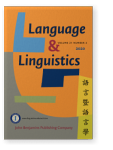Vol. 21:2 (2020) ► pp.351–374
Light verb ellipsis constructions in Korean
Drawing on the fact that the light verb ha- ‘do’ in Korean may or may not be elided in negative sentences, I offer a syntactic analysis for the light verb ellipsis in which the various types of light verbs belong to distinct heads, such as v, Appl, and Voice. Hierarchically, they occupy different syntactic positions. Thus, the light verb ellipsis ascribes itself to a syntactic hierarchy. The ellipsis behavior of various types of the light verb distinguishes them in a way that implicates structure, not other factors, such as semantics. The syntactic analysis put forth here constitutes substantive evidence supporting the configurational theory of argument structures in which different theta roles can be mapped into various syntactic positions.
Article outline
- 1.Introduction
- 2.Background
- 2.1Light verb constructions
- 2.2Distributed Morphology
- 2.3Argument-introducing heads and theta-roles
- 3.Light verb ellipsis
- 4.Different types of light verb ha- and distinct verbal heads
- 4.1Root ha-
- 4.2Agentive and Stative ha-
- 4.3Actional Experiential ha-
- 4.4Stacking ha-
- 4.5Discussion
- 5.Conclusion: Theoretical implications
- Acknowledgements
- Notes
- Abbreviations
-
References
For any use beyond this license, please contact the publisher at [email protected].
